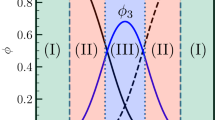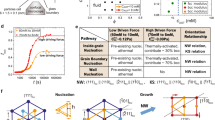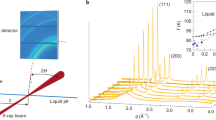Abstract
Most research into microstructure formation during solidification has focused on single-crystal growth ranging from faceted crystals to symmetric dendrites. However, these growth forms can be perturbed by heterogeneities, yielding a rich variety of polycrystalline growth patterns. Phase-field simulations show that the presence of particulates (for example, dirt) or a small rotational–translational mobility ratio (characteristic of high supercooling) in crystallizing fluids give rise to similar growth patterns, implying a duality in the growth process in these structurally heterogeneous fluids. Similar crystallization patterns are also found in thin polymer films with particulate additives and pure films with high supercooling. This duality between the static and dynamic heterogeneity explains the ubiquity of polycrystalline growth patterns in polymeric and other complex fluids.
This is a preview of subscription content, access via your institution
Access options
Subscribe to this journal
Receive 12 print issues and online access
$259.00 per year
only $21.58 per issue
Buy this article
- Purchase on Springer Link
- Instant access to full article PDF
Prices may be subject to local taxes which are calculated during checkout





Similar content being viewed by others
References
Cahn, R.W. The Coming of Materials Science (Pergamon, Oxford, 2001).
Gunton, J.D., San Miguel, M. & Sahni, P. in Phase Transitions and Critical Phenomena Vol. 8 (eds Domb, C. and Lebowitz, J.L.) 267–466 (Academic, London, 1983).
Ferreiro, V., Douglas, J.F., Warren, J.A. & Karim, A. Nonequilibrium pattern formation in the crystallization of polymer blend films. Phys. Rev. E 65, 042802 (2002).
Ferreiro, V., Douglas, J.F., Warren, J.A. & Karim, A. Growth pulsations in symmetric dendritic crystallization in polymer blend films. Phys. Rev. E 65, 051606 (2002).
Woodward, A.E. Atlas of Polymer Morphology (Hanser, New York, 1988).
Fleury, V. Branched fractal patterns in non-equilibrium electrochemical deposition from oscillatory nucleation and growth. Nature 390, 145–148 (1997).
Beers, K.L., Douglas, J.F., Amis, E.J. & Karim, A. Combinatorial measurement of crystallization growth rate and morphology in thin films of isotactic polystyrene. Langmuir 19, 3935–3940 (2003).
Keith, H.D. & Padden, F.J. Crystallization of polymers from the melt and the structure of bulk semicrystalline polymers. J. Appl. Phys. 34, 2409–2421 (1963).
Gránásy, L. et al. Growth of 'dizzy dendrites' in a random field of foreign particles. Nature Mater. 2, 92–96 (2003).
Ryshchenkow, G. & Faivre, G. Bulk crystallization of liquid selenium. J. Non-Cryst. Solids 87, 221–235 (1988).
Magill, J.H. Spherulites: A personal perspective. J. Mater. Sci. 36, 3143–3164 (2001).
Tracht, L. et al. Length scale of dynamic heterogeneities at the glass transition by multidimensional nuclear magnetic resonance Phys. Rev. Lett. 81, 2727–2730 (1998).
Russell, E.V. & Israeloff, N.E. Direct observation of molecular cooperativity near the glass transition. Nature 408, 695–68 (2000).
Ediger, M.D. Spatially heterogeneous dynamics in supercooled liquids. Ann. Rev. Phys. Chem. 51, 99–128 (2000).
Chang, I. & Sillescu, H. Heterogeneity at the glass transition: Translational and rotational self-diffusion. J. Phys. Chem. B 101, 8794–8801 (1997).
Weeks, E.R., Crocker, J.C., Levitt, A.C., Schofield, A. & Weitz, D.A. Three dimensional imaging of structural relaxation near the colloidal glass transition. Science 287, 627–631 (2000).
Kegel, W.K. & van Blaaderen, A. Direct observation of dynamical heterogeneities in colloidal hard-sphere suspensions. Science 287, 290–293 (2000).
Bennemann, C., Donati, C., Baschnagel, J. & Glotzer, S.C. Growing range of correlated motion in a polymer melt on cooling towards the glass transition. Nature 399, 246–249 (1999).
Mel'cuk, A.I., Ramos, R.A., Gould, H., Klein, W. & Mountain, R.D. Long-lived structures in fragile glass-forming liquids. Phys. Rev. Lett. 75, 2522–2525 (1995).
Donati, C. et al. Stringlike cooperative motion in a supercooled liquid. Phys. Rev. Lett. 80, 2338–2341 (1998).
Ngai, K.L., Magill, J.H. & Plazek, D.J. Flow, diffusion and crystallization of supercooled liquids: Revisited. J. Chem. Phys. 112, 1887–1892 (2000).
Rössler, E. Indication for a change in diffusion mechanism in supercooled liquids. Phys. Rev. Lett. 65, 1595–1598 (1990).
Masuhr, A., Waniuk, T.A., Busch, R. & Johnson, W.L. Time scales for viscous flow, atomic transport, and crystallization in the liquid and supercooled liquid states of Zr41.2Ti13.8Cu12.5Ni10.0Be22.5 . Phys. Rev. Lett. 82, 2290–2293 (1999).
Swallen, S.F., Bonvallet, P.A., McMahon, R.J. & Ediger, M.D. Self-diffusion of tris-naphthylbenzene near the glass transition temperature. Phys. Rev. Lett. 90, 015901 (2003).
Oxtoby, D.W. Density functional methods in the statistical mechanics of materials. Annu. Rev. Mater. Res. 32, 39–52 (2002).
Boettinger, W.J., Warren, J.A., Beckermann, C. & Karma, A. Phase-field simulation of solidification. Annu. Rev. Mater. Res. 32, 163–194 (2003).
Hoyt, J.J., Asta, M. & Karma, A. Atomistic and continuum modeling of dendritic solidification. Mater. Sci. Eng. Rep. R 41, 121–163 (2003).
Gránásy, L., Börzsönyi, T. & Pusztai, T. Nucleation and bulk crystallization in binary phase field theory. Phys. Rev. Lett. 88, 206105 (2002).
Gránásy, L., Börzsönyi, T. & Pusztai, T. Crystal nucleation and growth in binary phase field theory. J. Cryst. Growth 237–239, 1813–1817 (2002).
Gránásy, L. & Pusztai, T. Diffuse interface analysis of crystal nucleation in hard-sphere liquid. J. Chem. Phys. 117, 10121–10124 (2002).
Gránásy, L. et al. Phase field theory of crystal nucleation in hard sphere liquid. J. Chem. Phys. 119, 10376–10382 (2003).
Kobayashi, R., Warren, J.A. & Carter, W.C. Vector-valued phase field model for crystallization and grain boundary formation. Physica D 119, 415–423 (1998).
Kobayashi, R., Warren, J.A. & Carter, W.C. Modeling grain boundaries using a phase-field technique. Physica D 140, 141–150 (2000).
Huisman, W.J. et al. Layering of a liquid metal in contact with a hard wall. Nature 390, 379–381 (1997).
Davidchack, R.L. & Laird, B.B. Simulation of the hard-sphere crystal-melt interface. J. Chem. Phys. 108, 9452–9462 (1998).
Warren, J.A., Kobayashi, R., Lobkovsky, A.E. & Carter, W.C. Extending phase field models of solidification to polycrystalline materials. Acta Mater. 51, 6035–6058 (2003).
Warren, J.A. & Boettinger, W.J. Prediction of dendritic growth and microsegregation patterns in a binary alloy using the phase-field method. Acta Met. Mater. 43, 689–703 (1995).
Hoyt, J.J. & Asta, M. Atomistic computation of liquid diffusivity, solid-liquid interfacial free energy, and kinetic coefficient in Au and Ag. Phys. Rev. B 65, 214106 (2002).
Grier, D., Ben-Jacob, E., Clarke, R. & Sander, L.M. Morphology and microstructure in electrochemical deposition of zinc. Phys. Rev. Lett. 56, 1264–1267 (1986).
Kobayashi, R. Modeling and numerical simulation of dendritic growth. Physica D 63, 410–423 (1993).
Ihle, T. & Müller-Krumbhaar, H. Fractal and compact growth morphologies in phase transitions with diffusion. Phys. Rev. E 49, 2972–2991 (1994).
Taguchi, K. et al. Growth shape of isotactic polystyrene crystals in thin films. Polymer 42, 7443–7447 (2001).
Utter, B. & Bodenschatz, E. Dynamics of low anisotropy morphologies in directional solidification. Phys. Rev. E 66, 051604 (2002).
Akamatsu, S., Faivre, G. & Ihle, T. Symmetry-broken double fingers and seaweed patterns in thin-film directional solidification of a nonfaceted cubic crystal. Phys. Rev. E 51, 4751–4773 (1995).
Lovinger, A.J. & Cais, R.E. Structure and morphology of poly(trifluoro-ethylene). Macromolecules 17, 1939–1945 (1984).
Ben-Jacob, E., Deutscher, G., Garik, P., Goldenfeld, N.D. & Lareah, Y. Formation of dense branching morphology in interfacial growth. Phys. Rev. Lett. 57, 1903–1906 (1986).
Lereah, Y. et al. Morphology of Ge:Al thin films: Experiments and model. Phys. Rev. E 49, 649–656 (1994).
Dudowicz, J., Freed, K.F. & Douglas, J.F. Flory-Huggins model of equilibrium polymerisation and phase separation in the Stockmayer fluid. Phys. Rev. Lett. 92, 045502 (2003).
Kumar, S.K. & Douglas, J.F. Gelation in physically associating polymer solutions. Phys. Rev. Lett. 87, 188301 (2001).
Bedrov, D., Smith, G.D. & Douglas, J.F. Influence of self-assembly on dynamical viscoelastic properties of telechelic polymer solutions. Europhys. Lett. 59, 384–390 (2002).
Acknowledgements
We thank Vincent Ferreiro (CNRS), Kathryn Beers (NIST) and Vincent Fleury (CNRS) for providing the images shown in Figs 1 and 4. This work has been supported by contracts OTKA-T-037323, ESA PECS No. 98005, and by the EU Integrated Project IMPRESS. T.P. acknowledges support by the Bolyai János Scholarship.
Author information
Authors and Affiliations
Corresponding author
Ethics declarations
Competing interests
The authors declare no competing financial interests.
Rights and permissions
About this article
Cite this article
Gránásy, L., Pusztai, T., Börzsönyi, T. et al. A general mechanism of polycrystalline growth. Nature Mater 3, 645–650 (2004). https://doi.org/10.1038/nmat1190
Received:
Accepted:
Published:
Issue Date:
DOI: https://doi.org/10.1038/nmat1190
This article is cited by
-
Cell invasion during competitive growth of polycrystalline solidification patterns
Nature Communications (2023)
-
Theoretical basis for phase field modeling of polycrystalline grain growth using a spherical-Gaussian-based 5-D computational approach
Materials Theory (2022)
-
Fast crystal growth at ultra-low temperatures
Nature Materials (2021)
-
Theoretical insights into the surface physics and chemistry of redox-active oxides
Nature Reviews Materials (2020)
-
Combined Effects of Ultrasonic Melt Treatment and Cu/Mg Solute on the Microstructure and Mechanical Properties of a Hypoeutectic Al-7Si Alloy
Metallurgical and Materials Transactions A (2019)



